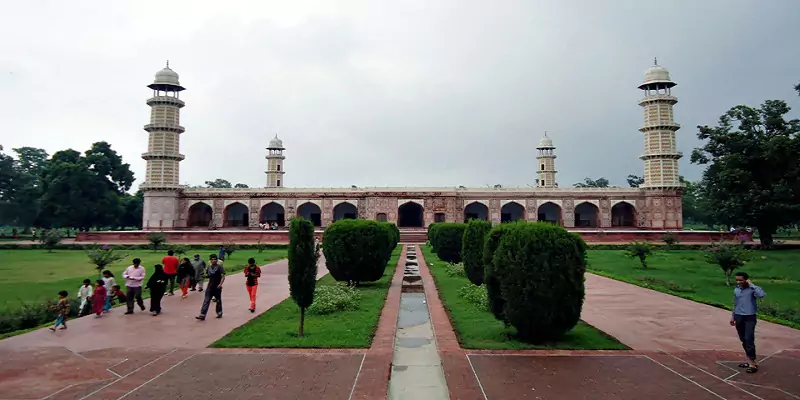Tomb of Emperor Jahangir
The Tomb of Emperor Jahangir, nestled in the heart of Lahore, Pakistan, is a magnificent testament to the Mughal era's grandeur and artistic finesse. Commissioned by Jahangir's son, Emperor Shah Jahan, this mausoleum stands as a poetic tribute to the fourth Mughal emperor, showcasing a harmonious blend of Persian, Central Asian, and indigenous architectural elements. Surrounded by a vast Charbagh garden and adorned with intricate marble and tilework, the Tomb of Emperor Jahangir is not merely a burial site; it is a symbolic representation of an emperor's legacy and a cultural jewel in the rich tapestry of Lahore's history.
Construction of the tomb began in 1627, shortly after Emperor Jahangir's death, and was completed in 1637. The mausoleum is strategically located along the right bank of the Ravi River, providing a picturesque setting with panoramic views of the surrounding landscape. The choice of this location reflects the Mughal penchant for creating serene, paradisiacal resting places for their departed rulers.
Approaching the Tomb of Emperor Jahangir, visitors are greeted by a monumental gateway known as the Akbari Sarai. This imposing entrance, adorned with intricate tilework and Persian calligraphy, serves as a prelude to the splendors within. The mausoleum stands at the center of a Charbagh garden, a traditional Mughal garden divided into four quadrants by water channels. The meticulous design of the garden symbolizes the paradise described in Islamic traditions, with flowing water, greenery, and geometric precision.
The main mausoleum is a majestic structure constructed primarily of red sandstone, providing a warm and earthy hue to the monument. The intricate details and inscriptions on the exterior walls showcase the Persian influence on Mughal architecture, with delicate floral patterns and calligraphy adorning the façade. The central chamber, housing the emperor's tomb, is adorned with a graceful marble cenotaph, an epitome of elegance.
The beauty of the Tomb of Emperor Jahangir lies not only in its architectural finesse but also in the ornamental details that grace its surfaces. The marble used for inlay work and decorative elements is of the highest quality, and the inscriptions include verses from the Quran, highlighting the religious and spiritual significance of the mausoleum.
One of the distinctive features of the tomb is the exquisite marble screen, known as the Jali. This intricately carved screen surrounds the cenotaph and serves as a delicate veil between the emperor's resting place and the outer world. The Jali is a masterpiece of craftsmanship, featuring geometric patterns, floral motifs, and Quranic verses delicately perforated into the marble.
Adjacent to the main mausoleum is the Akbari Sarai, a spacious courtyard enclosed by a double-story structure. The courtyard served as a space for visitors and pilgrims and includes a mosque and other auxiliary rooms. The Akbari Sarai reflects the Mughal tradition of providing facilities for travelers and devotees visiting the tomb.
The Charbagh garden surrounding the mausoleum is itself a work of art. Laid out in the classic Persian style, the garden is a geometrically precise paradise with a central water channel and fountains. The garden is meticulously landscaped, featuring a variety of plant species, including cypress, pine, and fruit-bearing trees, adding to the overall visual appeal.
As one strolls through the Charbagh, the garden's design encourages a sense of tranquility and contemplation. The strategically placed water channels symbolize the four rivers of paradise, contributing to the garden's spiritual ambiance. The symmetrical layout and careful selection of flora create a serene environment that transports visitors to the bygone era of Mughal splendor.
The Tomb of Emperor Jahangir has endured the ravages of time and undergone restoration efforts to preserve its historical and architectural significance. The meticulous restoration work aimed to repair weathering, address structural issues, and revitalize the intricate decorative elements, ensuring that the mausoleum remains a living testament to Mughal craftsmanship.
The tomb complex is not just a historical relic but a living space that continues to be a center for cultural and religious activities. Pilgrims and visitors from across the globe converge at the mausoleum, paying homage to Emperor Jahangir and marveling at the artistic brilliance of the Mughal era. The annual Urs ceremony, commemorating the emperor's death anniversary, is a significant event that attracts devotees and enthusiasts alike.
The Tomb of Emperor Jahangir is not isolated in its historical context; it is part of a larger ensemble that includes the adjacent Tomb of Empress Nur Jahan. The positioning of these tombs within proximity underscores the profound connection between Emperor Jahangir and his empress, further enriching the historical narrative.
In conclusion, the Tomb of Emperor Jahangir in Lahore stands as a testament to the enduring legacy of the Mughal Empire. Its architectural grandeur, meticulous garden design, and ornamental details make it a cultural jewel in the heart of Lahore. As visitors traverse the Charbagh and marvel at the intricacies of the mausoleum, they are transported to a time when Mughal emperors sought to immortalize their presence through structures that transcended earthly bounds. The Tomb of Emperor Jahangir, with its serene beauty, remains a beacon of Mughal artistry and a cherished heritage site in the heart of Pakistan.

